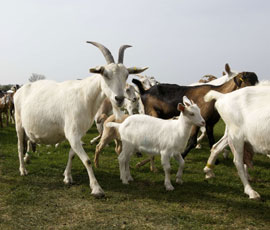Schmallenberg found in UK goats and alpacas

The Schmallenberg virus has been found in goats and alpacas in Britain for the first time.
The Animal Health and Veterinary Laboratories Agency (AHVLA) reported two cases of the virus in goats in East Sussex and one case of Schmallenberg antibodies in an alpaca in Northamptonshire.
An AHVLA spokesman said: “We were aware the Schmallenberg virus can affect goats and alpacas, but these are the first confirmed cases we have had in the UK so far.
“They are both serological results [from blood and plasma] which show that the antibodies to Schmallenberg are in the blood stream which does not mean that the disease has manifested itself.
“Although this development is not entirely unexpected, with any new presentation of the disease, it’s a concern.”
The AHVLA has asked farmers with goats and alpacas to look out for the symptoms of Schmallenberg virus and report any suspicious cases to vets.
The virus causes birth defects in lambs, goats and calves born to infected mothers. Typical symptoms of the virus in cattle include fever, reduced milk yield and diarrhoea.
There is no evidence that the virus can be transmitted from animal to animal. Scientists believe the disease is spread by infected biting midges.
Schmallenberg antibodies have also been detected in antibodies in deer and wild boar in continental Europe, according to European veterinary experts. But there are no confirmed cases in deer or wild boar in the UK so far.
Updated testing results, released on Wednesday (27 February), showed a total of 1,531 cases have now been confirmed in England, Scotland and Wales – a 26% increase from the previous total of 1,211 in January.
Elsewhere, at an animal health and welfare breakout at the NFU conference on Thursday (28 February), DEFRA deputy chief veterinary officer Alick Simmons said the Schmallenberg virus had now been detected in every county in England and Wales.
Where Schmallenberg has been detected or confirmed, sheep farmers have suffered relatively high lambing losses this season – particularly in early lambing flocks and synchronised flocks.
But while the impact of the virus was “dramatic and very upsetting” for those farmers affected, its effect was “relatively small”, he said.
“There may be pain for a year or so, but as immunity builds up in the national flock and herd, the likelihood is the disease will become less and less relevant because the exposure of the national flock will be almost complete.”
Alick Simmons, DEFRA deputy chief veterinary officer
Because the Schmallenberg virus has spread around most of the country, scientists believe large amounts of animals will have been exposed and able to build up immunity.
“The faster this disease spreads around Britain, the better it is,” added Dr Simmons.
“There may be pain for a year or so, but as immunity builds up in the national flock and herd, the likelihood is the disease will become less and less relevant because the exposure of the national flock will be almost complete.”
The disease has almost certainly spread to Cumbria and Scotland, he said, by natural effects rather than through movements. And late lambing flocks in March, April and May, could suffer losses, he warned.
But if ewes and new lambs were exposed to the disease in July, August and September, it was likely that those animals will have been solidly immune prior to going to the tup, he said.
“If that’s the case, then there’s a likelihood of there being relatively little disease. But we are still in the very early stages of understanding this disease,” he said.
Dr Simmons said it was still the case the Schmallenberg virus was not a zoonotic disease and does not infect to people – either by direct transmission or eating meat from animals infected by Schmallenberg.
A vaccine to protect livestock against the disease, produced by MSD Animal Health, has been submitted to the Veterinary Medicines Directorate (VMD), and is waiting approval for full commercial use.
